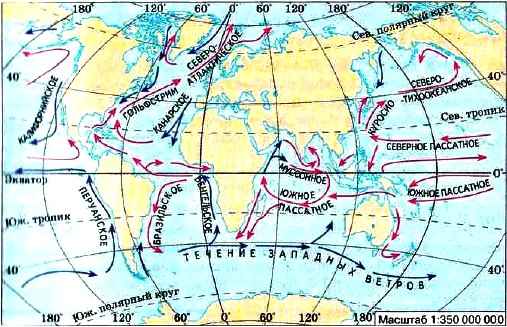- What types of water movement in the ocean do you know? List the causes that cause them.
- What are ocean currents? How do they differ?
Continuous movement is one of the features of ocean waters. No wonder the motto of the submarine "Nautilus" in the famous novel by Jules Verne was the phrase: "Mobile in the mobile." In the class b course, you have already become acquainted with the types of water movements in the ocean, you know the main reason for their formation. The direction of the currents is determined not only by constant winds, but also by the deflecting force of the Earth's rotation around its axis, the topography of the bottom, and the outlines of the continents.
Surface currents have the greatest influence on the nature of the ocean and land. In the ocean, they form a giant circular movement of surface waters. How does it arise? Let's consider this on the example of the northern part of the Atlantic Ocean (Fig. 25).
The northeast trade wind drives water masses from the coast of Africa to the west, forming the North Trade Wind Current. Off the eastern coast of South America, it deviates to the northwest and enters the Gulf of Mexico, from where the Gulf Stream is formed. It penetrates into temperate latitudes, where westerly winds act, moving water masses to the east. This movement of the waters is also facilitated by the force of the Earth's rotation, which deflects these waters to the right. This is how the North Atlantic Current is formed, bringing warm waters to temperate and polar latitudes. The excess of water from these latitudes flows south, mixes off the coast of Africa with cold waters rising from the depths and forms the Canary Current. Thus, in the northern part of the Atlantic Ocean, a giant circular movement of waters clockwise occurs. A similar picture is observed in the southern part of this ocean (see map). The circular movement of the waters takes place here counterclockwise, since in the Southern Hemisphere the movement deviates to the left.

Rice. 25. The main surface currents in the oceans
A similar picture of the main currents exists in the Pacific Ocean. The analogue of the Gulf Stream here is the Kuroshio, the analogue of the Benguela Stream is the Humboldt Current (or Peruvian), etc. The patterns of currents in the Indian and Arctic Oceans are somewhat different, since they have a special geographical position.
In the Southern Hemisphere, in temperate latitudes, a circular Antarctic Current (or the Western Wind Current) is formed - the most powerful in the World Ocean.
Thus, a certain regularity is observed in the distribution of surface currents in the ocean. The general scheme of currents coincides with the scheme of constant winds. The trade winds move water masses to the west, and the westerly winds of temperate latitudes, respectively, to the east, but at the same time, the force of the Earth's rotation around its axis deflects these waters to the right in the Northern Hemisphere and to the left in the Southern. Therefore, the currents form huge circular movements of the waters (see Fig. 25).
Currents have a huge impact on the redistribution of heat in the ocean. Warm waters in the western parts of the ocean are sent to the poles, like a water heating system, heating the high latitudes of the Earth, and in the east they return to the equator cooled.
Most often, cold and warm currents come close to each other in temperate latitudes. As a result, areas of convergence of waters with different properties are formed, eddies appear. These phenomena in the ocean are reflected in the properties of air masses formed over the ocean, and then manifest themselves in weather conditions on land located in temperate latitudes.
- Find in the text an explanation of the causes of ocean currents. What is the general rule for the movement of the main currents?
- Follow the course of the O°C isotherm in the Northern Hemisphere on the map and at the same time establish the role of warm and cold currents in the formation of the land climate. What effect do currents have on rainfall over North America and Eurasia?
